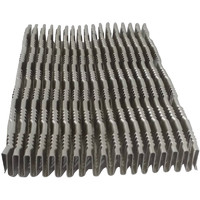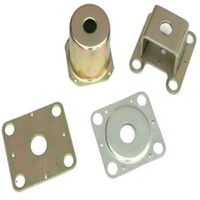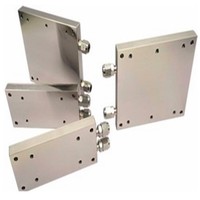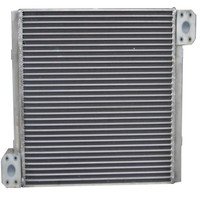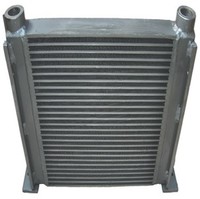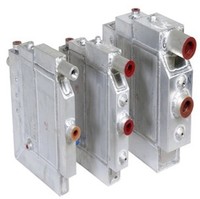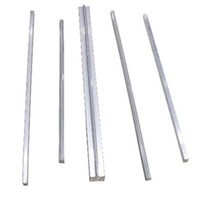Heat exchanger part aluminum cooling fins turbulator
Product Quick Detail
- FOB Price
- USD $5,300.00 / Piece
- Minimum Order
- 0.5
- Packaging
- N/A
- Delivery
- 15 Days
Specifications
1. Product description
In the study of heat transfer, fins are surfaces that extend from an object to increase the rate of heat transfer to or from the environment by increasing convection. The amount of conduction, convection, or radiation of an object determines the amount of heat it transfers. Increasing the temperature gradient between the object and the environment, increasing the convection heat transfer coefficient, or increasing the surface area of the object increases the heat transfer. Sometimes it is not feasible or economical to change the first two options. Thus, adding a fin to an object, increases the surface area and can sometimes be an economical solution to heat transfer problems.
Because fins are used to improve heat transfer, it is important to allow open spaces toward optimization. In other words, the shape of fins must be optimized such that the heat transfer density is maximized when the space and the materials used for the finned surfaces are constraints
Fins are most commonly used in heat exchanging devices such as radiators in cars, computer CPU heatsinks, and heat exchangers in power plants. They are also used in newer technology such as hydrogen fuel cells. Nature has also taken advantage of the phenomena of fins. The ears of jackrabbits and fennec foxes act as fins to release heat from the blood that flows through them.
2. Specification
2.1. Material: Aluminum alloy like AA3003,AA1070,AA6061,etc are typical used;
2.2. Temper for aluminum alloy: H14,H16,O are typical;
2.3. Fins type
Plain,serrated,perforated,wavy,louvered type is typical
2.4. Dimension
Width up to 300mm; Thickness from 0.1mm to 0.5mm; Height up to 50mm; FPI from 6 to 12;
3. Surface finish
Mill finish and cleaning
4. Packing way
To be packed in plywood case with protection film
5. Application
Typically used as parts for heat exchanger
In the study of heat transfer, fins are surfaces that extend from an object to increase the rate of heat transfer to or from the environment by increasing convection. The amount of conduction, convection, or radiation of an object determines the amount of heat it transfers. Increasing the temperature gradient between the object and the environment, increasing the convection heat transfer coefficient, or increasing the surface area of the object increases the heat transfer. Sometimes it is not feasible or economical to change the first two options. Thus, adding a fin to an object, increases the surface area and can sometimes be an economical solution to heat transfer problems.
Because fins are used to improve heat transfer, it is important to allow open spaces toward optimization. In other words, the shape of fins must be optimized such that the heat transfer density is maximized when the space and the materials used for the finned surfaces are constraints
Fins are most commonly used in heat exchanging devices such as radiators in cars, computer CPU heatsinks, and heat exchangers in power plants. They are also used in newer technology such as hydrogen fuel cells. Nature has also taken advantage of the phenomena of fins. The ears of jackrabbits and fennec foxes act as fins to release heat from the blood that flows through them.
2. Specification
2.1. Material: Aluminum alloy like AA3003,AA1070,AA6061,etc are typical used;
2.2. Temper for aluminum alloy: H14,H16,O are typical;
2.3. Fins type
Plain,serrated,perforated,wavy,louvered type is typical
2.4. Dimension
Width up to 300mm; Thickness from 0.1mm to 0.5mm; Height up to 50mm; FPI from 6 to 12;
3. Surface finish
Mill finish and cleaning
4. Packing way
To be packed in plywood case with protection film
5. Application
Typically used as parts for heat exchanger
- Country: China (Mainland)
- Business Type: Manufacturer
- Market:Africa,Americas,Asia,Emerging Markets,Europe,European Union,G20,Middle East,Oceania
- Founded Year:2014
- Address:NO.12 EAST MOZHOU ROAD, JIANGNING DISTRICT, NANJING
- Contact:Frances Cai
Other products from NANJING METALLI INDUSTRIAL CO., LIMITED
Relate products of Heat exchanger part aluminum cooling fins turbulator
Heat exchanger part aluminum side bar
1. Specification 1.1. Material: Appropriate aluminum alloys like AA3003,AA6061,6063,etc. 1.2. Temper: H112 is typical 1.3. Dimension Length up to 6 meters; Width up to 20mm; Height up to 20mm; 1.4. Shape Flat,square,rectangle or customized shape 2. Surface finish Mill finish 3. ...

